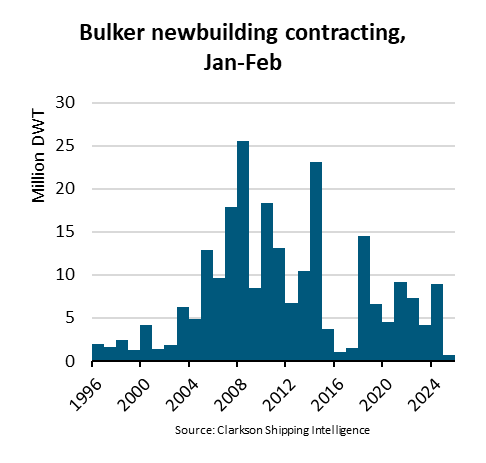 oceanis co-founder Erlend Sommerfelt Hauge highlights the opportunities for Chinese lessors to fill the gap left by Western financiers that have shifted focus
oceanis co-founder Erlend Sommerfelt Hauge highlights the opportunities for Chinese lessors to fill the gap left by Western financiers that have shifted focus
Chinese leasing has seen remarkable growth in the maritime industry. Over the past decade, Western banks have faced challenges and struggles due to an evolving regulatory landscape and changing strategies, namely wrapped up in Environmental, Social, and Governance (ESG) concerns. While Western financial institutions have shifted their focus towards larger domestic shipping conglomerates, alternative financiers can be restrictive and costly.
European ship ownership is marked by fragmentation, as the majority of vessels are owned by small and medium-sized shipowners that are managing fleets of fewer than 20 ships. With the largest European banks all chasing the largest ship owning groups, the resulting supply-demand imbalance in financing has created opportunities that can be capitalized on, and is already being realized for Chinese leasing companies.
The Chinese shipping sector has experienced significant expansion, boasting increased vessel numbers, industry expertise, and sophistication. Unsurprisingly, given China’s influential position in the shipping industry, leasing companies in the region that stem from shipbuilding and financial backgrounds are continuously advancing, influencing supply and demand dynamics.
As industry expertise has expanded among Chinese lessors that have become attuned to the cyclical nature of the markets, significant new business prospects will arise. The departure of major banks has resulted in more options for Western shipowners, but it has also become more crowded with different lenders, including local banks with specialized knowledge, and less regulated yet more flexible alternative creditors. Chinese leasing stands out by offering higher leverage than banks but with more competitive pricing than the European alternative lenders, making their loan product appealing among Western shipowners.
The offshore supply sector has become a prime example of a case where many European banks have retreated, with alternative lenders are filling the void together with some banks. With the energy industry investing more into oil and gas projects to meet projected supply and demand, there is a long-term trend towards maintaining existing production and finding new resources. As a result, offshore supply companies can get into more profitable, long-term agreements. Chinese leasing companies have an opportunity to follow the example of flexible lenders who during the last year have been able to select good projects with strong economics while facing modest competition.
Lending to the offshore supply sector declined significantly after OPEC and US shale producers ended the previous bull market in 2014. However, many European lenders do not seem inclined to re-enter this market due to concerns of further losses and the impact of ESG regulations. Therefore, banks are forgoing oil and gas projects, deciding instead to favor investments in dry bulk, tankers and container vessels. Some are even exiting the shipping industry entirely for less carbon-intensive sectors, driven by the prevailing trend and political climate within Western lenders of transitioning away from fossil fuels.
This market gap presents an enticing opportunity for Chinese lessors to provide the supply of finance to meet the demand. The strong market provides stable cash flows, reducing volatility for lenders, but also offers higher pricing potential. The withdrawal of European lenders from offshore financing potentially opens another avenue for Chinese lessors to capitalize on, especially in the seemingly more stable offshore sector.
Both Western small and medium-sized shipowners, in traditional shipping segments, and the offshore supply sector offer opportunities for Chinese leasing. For shipping projects coming from small- and medium-sized ship owners the competition is often high from European commercial banks. However, existing financing options within Western markets are often more costly or restrictive than those available for larger borrowers, particularly when they do not originate from major banks.
In addition, financing of Offshore vessels is yet more expensive and restrictive than financing more typical Dry Bulk, Tanker and Container vessels. These differences are clearly shown in the market reports shared quarterly by oceanis, in which the average financing cost for smaller financings is around 75 basis points while offshore financings are typically 200 basis points more expensive than financing for cargo-carrying vessels with similarly strong contract coverage.
As Chinese lessors gain more experience in the market, they will develop a deeper understanding of the cyclical nature of different sectors, enabling them to seize opportunities promptly.
The opinions expressed herein are the author's and not necessarily those of The Xinde Marine News.
Please Contact Us at:
media@xindemarine.com


 Ningbo Containerized Freight Index Weekly Commentar
Ningbo Containerized Freight Index Weekly Commentar  Ningbo Containerized Freight Index Weekly Commentar
Ningbo Containerized Freight Index Weekly Commentar  Ningbo Containerized Freight Index Weekly Commentar
Ningbo Containerized Freight Index Weekly Commentar  BIMCO Shipping Number of the Week: Bulker newbuildi
BIMCO Shipping Number of the Week: Bulker newbuildi  Ningbo Containerized Freight Index Weekly Commentar
Ningbo Containerized Freight Index Weekly Commentar  Ningbo Containerized Freight Index Weekly Commentar
Ningbo Containerized Freight Index Weekly Commentar